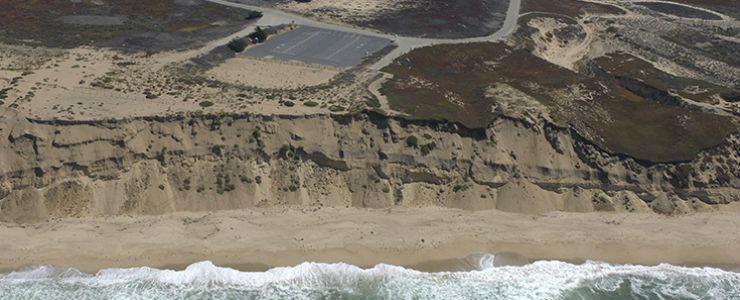Marine and Coastal Geology
The Marine and Coastal Geology cluster group includes a diverse group of Earth scientists who work on the geological evolution of ocean basins extending from the coastal zone where most human interactions occur, to the active continental margins where oceanic plates are subducted and continental accretion occurs, to ocean ridges where new lithosphere is created and seafloor spreading takes place. While the research of this group varies widely in methods, physical setting and purpose, there are some common themes, which include the nature and importance of fluid or hydrothermal flow through the Earth’s crust beneath ocean ridges, and the process of subduction where old seafloor is destroyed at ocean trenches.
Some of this research is based on ocean drilling, including both samples collected at depth beneath the seafloor, and also the installation of monitoring equipment and measurements of temperatures, pressures, and fluid chemistry from deep boreholes. Along the coastline, where people and development now occupy geologically active environments, the issues of coastal hazards including coastal retreat, El Niño impacts, tsunamis, and a rising sea level and how we respond or adapt to these processes are areas of active research.
The Pacific Coastal and Marine Science Center of the United States Geological Survey is located between the main UCSC campus and the Coastal Science Campus. Through a Cooperative Agreement, many of the USGS coastal and marine scientists have research associate appointments with the Institute and have developed collaborative research projects, serve on graduate committees, and support a large number of graduate and undergraduate students. The USGS scientists conduct multidisciplinary research in the coastal and offshore waters of California, Oregon, Washington, Alaska, Hawaii and other US Pacific Islands.
Faculty (Professors and Adjuncts) and Professional Researchers affiliated with the Marine and Coastal Geology Cluster Group:
Andrew Fisher, Professor of Earth & Planetary Sciences: Surface water-groundwater interactions; Hydrogeology and thermal evolution of oceanic crust, seamounts, ridge flanks, and convergent margins; Numerical modeling of coupled flows; Groundwater recharge; Aquifer characterization, testing, facies controls on hydrologic properties; Groundwater aquifer-marine interactions; Long-term monitoring, geothermal instrumentation.
Gary Griggs, Distinguished Professor of Earth & Planetary Sciences: Coastal zone and ranges from coastal evolution and development, through shoreline processes, coastal hazards and coastal engineering, and sea level rise.
Ana Christina Ravelo, Professor and Chair of Ocean Sciences, Director of Geophysics & Planetary Physics: Stable isotope geochemistry, paleoceanography, paleoclimatology.
James Zachos, Professor of Earth & Planetary Sciences: Problems related to the biological, chemical, and climatic evolution of late Cretaceous and Cenozoic oceans.

